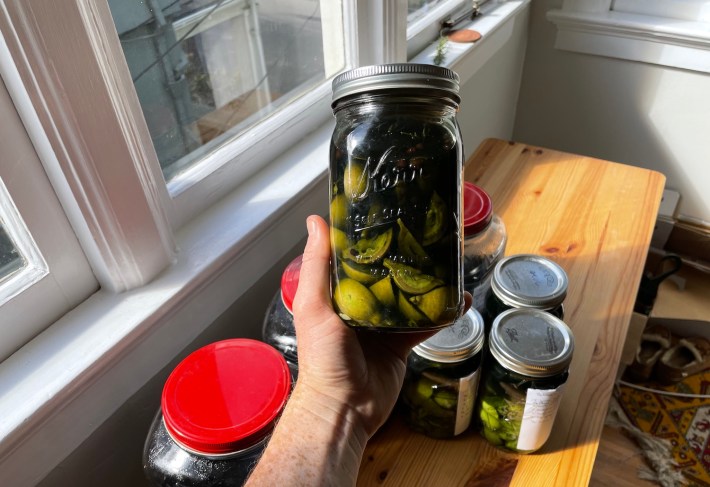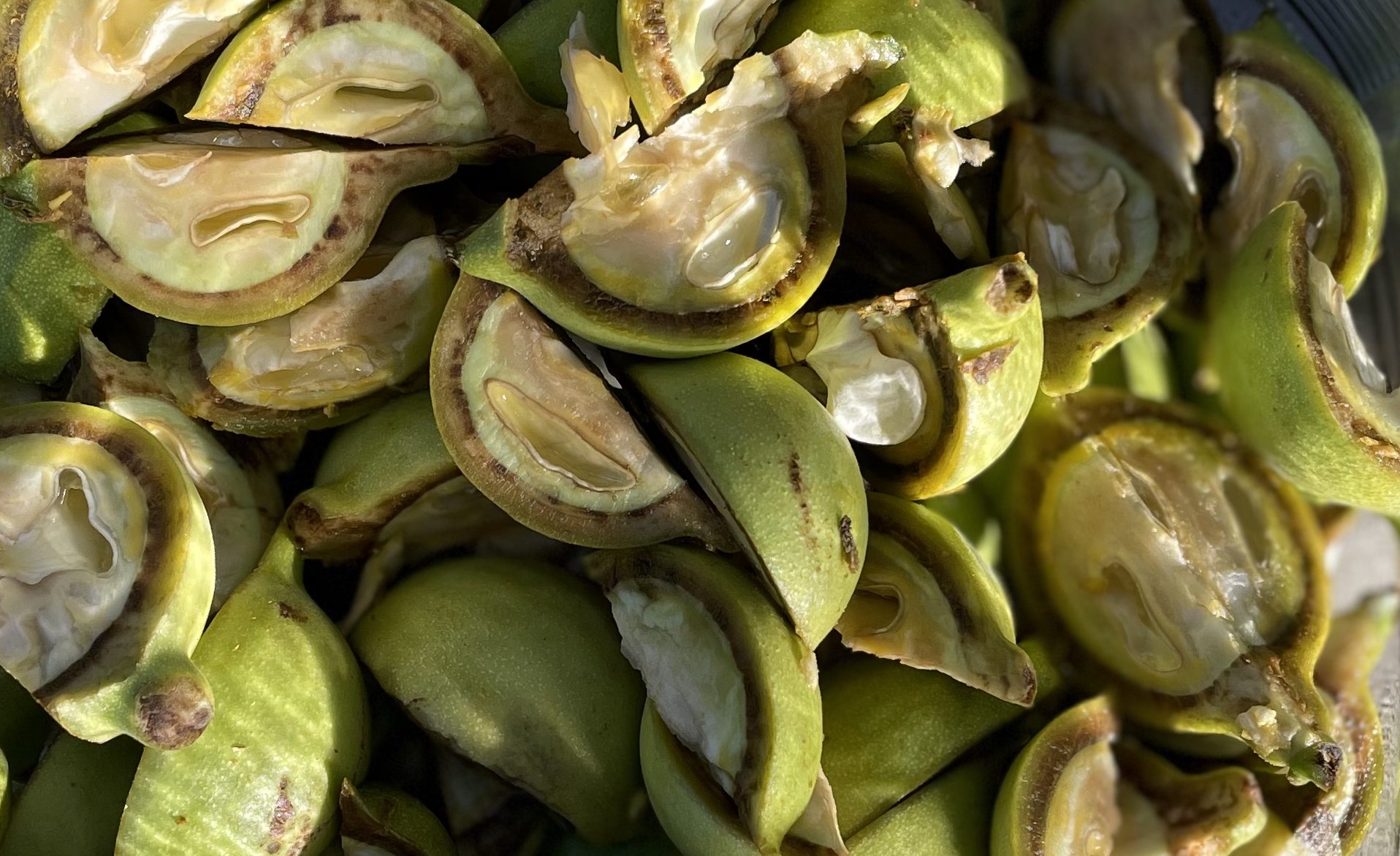One serious affinity I developed during the pandemic was a fondness for amari. I've been an evangelist for the pleasant mouthwashiness of Fernet for years because it's the only drink you can get at most bars that simultaneously tastes "good" and "like an old-timey cure-all intended to alleviate the vapors," and a year's worth of leisure time spent mostly walking around in the woods looking at plants and mushrooms somehow helped get me even more into the bitter stuff. The journey kicked off when we came upon a syrupy orange elixir from a local distiller who was pals with the old farm. It was the ideal amaro: relatively low alcohol by volume and a celebration of local agriculture and flora. Throughout the year, we tried some Italian traditionals, a rhubarb one that tasted like smoked mud (in a good way), and we even gathered a bagful of local herbs and citrus peels to infuse our own.
Eventually this path led us to a substance that is not an amaro, yet marries together all of its best qualities: nocino, an inky walnut infusion I will teach you how to make today. My partner's grandmother Sally has lived her entire adult life on a nut tree farm in Woodland, Calif., a farm whose defining features are a pair of Northern California black walnut trees that tower over the 119-year-old house and the gnarled olive trees that line delineate the fields from the barn. Over the years, we've picked 600 pounds of olives and pressed them for their oil and even made nocino once before, but I wasn't particularly interested in extracting rarified ooze from nut products. After a year spent marveling at trees and sipping bitter liqueurs, however, infusing our own nocino from her spare walnuts made all the sense in the world. So this past week, we plucked a couple hundred green pre-walnuts, processed them (more on this, obviously, later), and started an operation that won't pay off until Christmas at the absolute earliest.
I do not presume to know what your access to a walnut tree is like. Maybe you also live on a farm with a walnut tree, perhaps you're stuck in the city miles from the nearest nut-bearing tree, or maybe you're like, "What, come on, even I have no idea what my walnut-tree access is like." But walnuts are more accessible than you might think! I went on a walk this morning and came across two nut-bearing walnut trees about two weeks away from ideal harvesting size. It can be done! What I am saying to you is this: If you can acquire—by foraging, asking a friend, buying online, or even badgering the nut person at a local farmer's market—even two dozen green walnuts, you are in for a total treat.
The earliest records referring to the the Pict people—a confederation of Celtic peoples who lived in what is now Scotland north of Hadrian's Wall, successfully resisted Roman conquest, and eventually helped drive the invaders off the island for good—were made in 297 CE by the Roman orator Eumenius, who described warriors that painted themselves blue before battle. The Picts get their name from a Latin phrase that translates to "painted people," and their origins as well as the degree to which they were a unified tribe or merely a loose alliance of locals are both unclear. Regardless, similar legends about the warriors of northern Britannia had echoed around the Empire for centuries. Julius Caesar, who tried and failed to conquer Britannia three hundred years earlier, wrote that the island's warriors "dye themselves with woad, which produces a blue colour, and makes their appearance in battle more terrible." This is probably apocryphal, and most early records of the inhabitants of Scotland were made by conquerors and their scribes, so we must unfortunately also take with the same grain of salt Roman legends that the Picts would quaff walnut infusions to commune "with goblins, elves, and goddesses."
Various European mythological traditions associate walnut trees with witches and dark mischief, and related nocino lore says that the druids had strict rules surrounding preparation. A group of barefoot virgins was supposed to pick an odd number of nuts the night before summer solstice, otherwise local witches would get to snack on them and fuel their mischievous acts. Nocino harvesters are also advised to leave the freshly plucked green walnuts out for a night so they can become "impregnated with a dew that is the panacea for all diseases." (Defector legal is telling me I can make "no such claim," so.)
Despite (or perhaps, because of) this spooky origin story, customs surrounding nocino production were ported over and given a Christianized flair once that became the official religion of the Roman Empire. John The Baptist was I guess born six months before Jesus, so his feast day on June 24 became a natural new host for a handful of midsummer traditions and solstice celebrations that needed to be de-paganized.
The Romans allegedly regarded the very shade of walnut trees as "baneful," which is likely because walnut trees produce a natural herbicide called juglone that kills certain competitors who come near its root system. Stonefruits tend to be fine, but apple trees will shrivel up and die. It's juglone that gives nocino its signature look, that of viridescent crude oil or lowkey sludgy soy sauce. The seemingly paradoxical color of the walnut goop is perhaps the single most appealing aspect of nocino. You are picking bright green walnuts, at the height of summer, and adding clear liquid to them, yet the end product looks like liquid obsidian. It sort of makes sense then that the drink has roots as a link between the solstices.
Nocino preparation is now associated with Italy's Emilia-Romagna region, and you can find it at most higher-end liquor stores or even sufficiently ambitious grocery stores. We used black walnuts for our nocino, though traditional recipes call for English walnuts (also known as Persian walnuts). Both work fine, though black walnuts tend to produce slightly more tannic nocini since they are richer in juglone. Black walnuts are native to the United States, and they grow throughout much of the eastern U.S., in patches in Texas, and along the west coast. English walnuts were introduced four centuries ago by the British, and they can also grow in the same sorts of climates.
Woodland, Calif.—as the name suggests—used to be a forest. Now it's as dry and dusty as most of the rest of the Valley. A full quarter of the nation's food comes from the Central Valley, which is a stunning statistic that quickly becomes depressing once you drive down I-5 and see the ecological nihilism inherent to the rapid industrialization of the valley and its production areas. Stunning riparian forests (described in a foundational academic paper as "similar to tropical jungles") once dominated the Valley, as its numerous channels flooded seasonally and dispersed nutrient-rich soil to impressive stands of walnut, sycamore, and cottonwood. Most of that is gone now. Within 20 years of California's annexation in 1848, the Valley's deforestation was noticeable. The Central Valley is now wholly industrialized, with the poisoned air and undrinkable water that follows hardcore environmental degradation. Even though 99 percent of the country's walnut production for export comes from California's Central Valley, we are lucky to have access to Sally's trees.
The recipe for nocino is pretty simple: You put nuts, liquor, and spices in a jar for a while and then you add some sugar, and then you wait. You want to stick with a ratio of 30 walnuts per liter of solvent, usually vodka, though some people use Everclear. We split the difference and went with an cocktail of vodka and 60 percent ABV Everclear for a mixture that wound up at 46 percent ABV. You will need to quarter your walnuts before you soak them, though this part is trickier than it might seem.
Juglone is a quick stainer, and if even this damn Cleveland Clinic is out here being like "Do not chop walnuts with your bare hands because it will hurt and turn your hands black," you should definitely not chop walnuts with your bare hands. My hands got all sticky and slightly singed from simply picking the walnuts. You should operate under the assumption that your walnuts will stain whatever surfaces they come in contact with, so wear gloves and an apron, and use a cutting board and a knife that is not your favorite knife. It is crucial that you use young, green walnuts that you can easily cut through without too much resistance. Because northern California is in the midst of yet another drought, our harvest on June 7 was about as late as we could go. Several required some force to quarter, and if we had waited another week, we'd be shit out of luck. John the Baptist and the local coven would probably be disappointed we jumped the gun by two-and-a-half weeks, but it was the only way. I assume you live in a less drought-stricken part of the country, since that area comprises, well, most of the rest of the country. I had luck checking out some feral walnut trees down in Santa Barbara, and they were still maybe a week away from being able to be plucked.
Anyway, once you have your walnuts quartered and covered, it is time to take some artistic license with your nocino. Since we picked 150 walnuts, we had enough to make five liters of tasty walnut sludge. Naturally, we opted to try seven slightly different recipes, three liters and four half-liters. I'll list a few out in full down in the comments, but they all adhere to the same schematic: 30 walnuts, a liter of infuser, the peel of one citrus fruit, and a small handful of warming spices and things of that nature. One batch had four cloves, one cinnamon stick, 10 coffee beans, the peel of half of an orange and half of a lemon, and half of a whole nutmeg, grated on all sides. Another had a segment of vanilla bean and some chopped ginger. Cardamom pods, whole cloves, and star anise pods feature heavily in most recipes. We went nutty on one and picked a bunch of fresh herbs from the garden and tossed them in with a tablespoon of peppercorns and couple of allspice berries. One was made up simply of walnuts and liquid. Think of what flavors you want to taste six months from now, when the sun is low in the sky, and work backwards from there.

Once your jar is good to go, give it a good shake and plop it down for a while somewhere cool and dark. Some recipes say to let it macerate for 40 days, some say to leave it for six whole months. You should shake it pretty often so the spices you added can do their thing. We're going to leave our brew for two months before we take the next step, which is adding some sugar. Many recipes call for maple syrup, and we're planning on using that, since it comes from a tree and that seems more coherent. The rough rule of thumb here is two cups of sweet stuff per liter of vodka. Strain your bundle of solids out of the now-blackened potion before you add the sweets. Again, some recipes say you should just add the sugar straight away, but we decided waiting was better, since it adheres to the more traditional recipes and gives the walnuts more time to soak on their own.
Once you've sweetened your nocino it is time to, you guessed, wait some more. Your nocino will be "ready" to drink within a couple of weeks, but at this point, you are in it for the long haul. Your mind is filled with images of witches performing sacred rites beneath the snowy boughs. You feel a deep, inexplicable connection to the black truffles invisibly swelling beneath the oaks of Emilia-Romagna. You are going to wait at least six more weeks before you even try your nocino, at which point you will hopefully taste some and think, "Needs more time in the oven." Yes, it does. The longer the nocino liquid chills, the more its flavors relax. Try it too early, and the tannins will strip your palate raw. If you wait, things mellow out and you are hopefully left with a smooth, nutty elixir to make you strong and remember the summer months, now as far from the present as possible. What I am saying to you is that you should open it either on winter solstice or on Christmas and have some. We made enough that some will age for years before we finish off this year's batch, which means we'll get to taste it at every stage. If the bitterness is too strong, or even if it is not, the most popular way to consume nocino is to drizzle some out on top of a scoop of vanilla ice cream. In this preparation, all the bitterness dilutes and you're just left with pure walnut essence. I'll see you back here in December for a little update.






